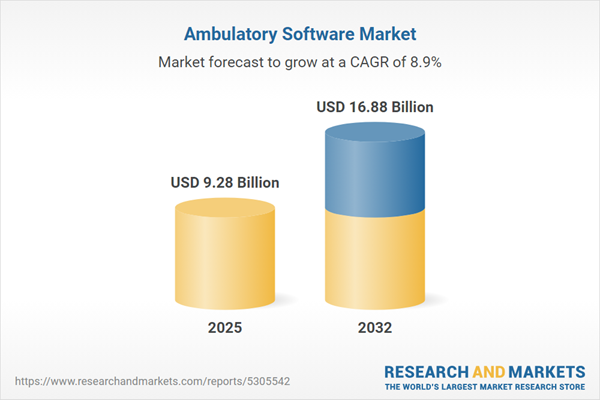Speak directly to the analyst to clarify any post sales queries you may have.
The ambulatory software market is rapidly evolving as healthcare organizations prioritize agile, interoperable platforms to strengthen efficiency, enhance compliance, and optimize outpatient workflows at scale.
Market Snapshot: Ambulatory Software Market Size and Growth Outlook
In 2024, the ambulatory software market is valued at USD 8.53 billion, with growth anticipated to USD 9.28 billion in 2025 and projection to USD 16.88 billion by 2032. This momentum is fueled by increasing demand for integrated electronic health record (EHR) platforms, a rapid shift toward automated billing solutions in outpatient clinics, and the expanding influence of telehealth. Providers are steadily adopting advanced digital tools to drive care coordination, improve patient experience, and streamline administrative management. Artificial intelligence, enhanced interoperability, and customizable deployment models are propelling organizations to adjust to changing compliance needs while maintaining a focus on operational resilience. Market vendors continue to advance product capabilities to address the sector’s requirements for agility, transparency, and multi-site integration.
Scope & Segmentation: Ambulatory Software Market Overview
- Delivery Mode: Cloud-based options such as public, private, and hybrid platforms deliver secure, scalable access and operational flexibility. On-premise solutions remain critical in settings with stringent local data controls or heightened compliance directives.
- Product Type: EHR systems, billing and practice management software, and remote engagement applications support key outpatient functions, from clinical documentation and administration to digital patient engagement.
- Business Size: Vendors address the specialized needs of small clinics, medium practices, and large-scale healthcare networks to align with infrastructure and operational requirements at every level.
- Component: Solutions span standalone software, full-suite platform bundles, integration and support services, and structured training designed to ease onboarding and digital adoption.
- End User: Ambulatory surgery centers, diagnostic labs, physician offices, and specialized clinics such as orthopedics and cardiology employ these solutions to achieve specific clinical efficiencies and workflow improvements.
- Geographical Coverage: The market adapts to policy and regulatory variation across regions including the Americas, Europe, Middle East, Africa, and Asia-Pacific, tailoring technology adoption to local compliance, operational, and infrastructure needs.
- Key Companies: Key vendors such as Epic Systems Corporation, Oracle Cerner Corporation, athenahealth Inc., eClinicalWorks LLC, NextGen Healthcare Inc., MEDITECH, GE Healthcare, Practice Fusion Inc., McKesson Corporation, and CureMD LLC drive advances in interoperability and clinical data security.
Key Takeaways for Executive Leadership
- Ambulatory software delivers end-to-end workflow integration, enhancing collaboration between clinical and operations teams to drive consistent outpatient performance and informed decisions.
- Artificial intelligence and machine learning tools support actionable analytics, equipping leaders to elevate strategic planning and target improvements in care delivery and resource use.
- Flexible cloud architectures, particularly private and hybrid models, offer scalable infrastructure that ensures secure accessibility and compliance for expanding healthcare enterprises.
- Ongoing investment in cybersecurity and compliance management is crucial for protecting sensitive health information and reinforcing the reliability of core care platforms.
- Interoperability, achieved through vendor-neutral APIs and collaboration, facilitates unified device connection and efficient multisite integration across networks.
Tariff Impact: Steering Sourcing and Cost Strategies
Current adjustments in U.S. tariff policy prompt healthcare organizations to reassess sourcing and deployment approaches in the ambulatory software sector. Senior leaders are increasingly leveraging regionalized delivery models and diverse supplier partnerships to mitigate risk while fortifying supply chain resilience. Cloud-first initiatives simplify regulatory adherence and deliver cost efficiencies, while customized deployments in private or hybrid environments underpin business continuity. Procurement teams balance operational agility and regulatory obligations to ensure uninterrupted delivery across their ecosystems.
Methodology & Data Sources
Insights in this report are built on primary interviews with healthcare executives, IT stakeholders, compliance teams, and regulatory officials, supplemented by targeted market surveys, to deliver comprehensive analysis of digital transformation patterns in ambulatory care.
Why This Report Matters
- Enables executive teams to guide investments in advanced, AI-enabled ambulatory software tailored to evolving strategic and operational priorities.
- Equips sourcing and procurement leaders to adapt practices for changing regulatory and market realities, minimizing operational risk while promoting resilience across global supply chains.
- Supports IT and technology leaders in aligning regional deployment strategies with enterprise IT infrastructure, compliance goals, and performance benchmarks.
Conclusion
This report provides senior decision-makers with strategic, actionable intelligence for navigating ambulatory software adoption, ensuring alignment with regulatory mandates and enabling operational excellence across modern healthcare landscapes.
Additional Product Information:
- Purchase of this report includes 1 year online access with quarterly updates.
- This report can be updated on request. Please contact our Customer Experience team using the Ask a Question widget on our website.
Table of Contents
3. Executive Summary
4. Market Overview
7. Cumulative Impact of Artificial Intelligence 2025
Companies Mentioned
The companies profiled in this Ambulatory Software market report include:- Epic Systems Corporation
- Oracle Cerner Corporation
- athenahealth, Inc.
- eClinicalWorks, LLC
- NextGen Healthcare, Inc.
- Medical Information Technology, Inc. (MEDITECH)
- GE Healthcare (General Electric Company)
- Practice Fusion, Inc.
- McKesson Corporation
- CureMD, LLC
Table Information
| Report Attribute | Details |
|---|---|
| No. of Pages | 186 |
| Published | November 2025 |
| Forecast Period | 2025 - 2032 |
| Estimated Market Value ( USD | $ 9.28 Billion |
| Forecasted Market Value ( USD | $ 16.88 Billion |
| Compound Annual Growth Rate | 8.9% |
| Regions Covered | Global |
| No. of Companies Mentioned | 11 |









